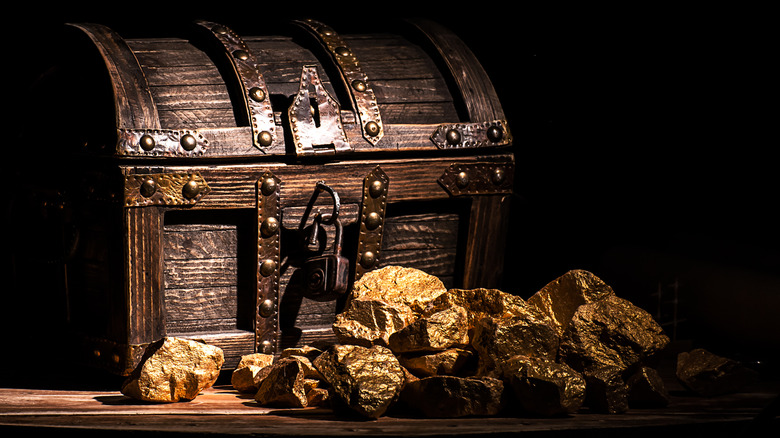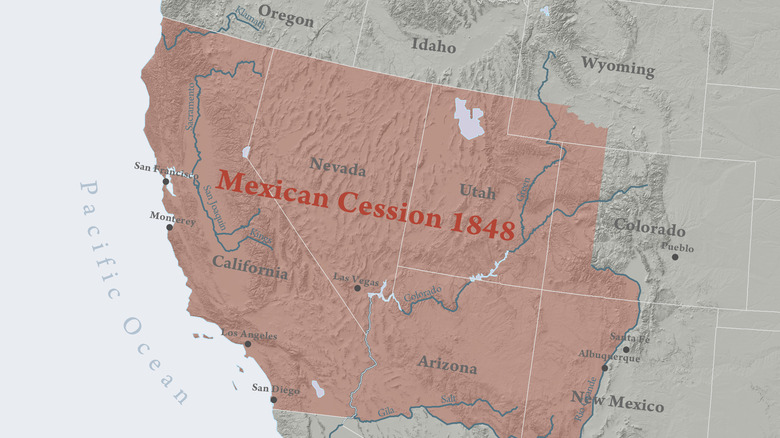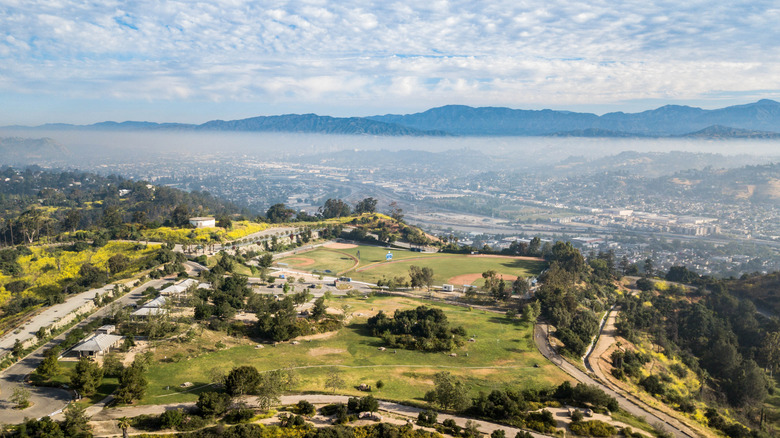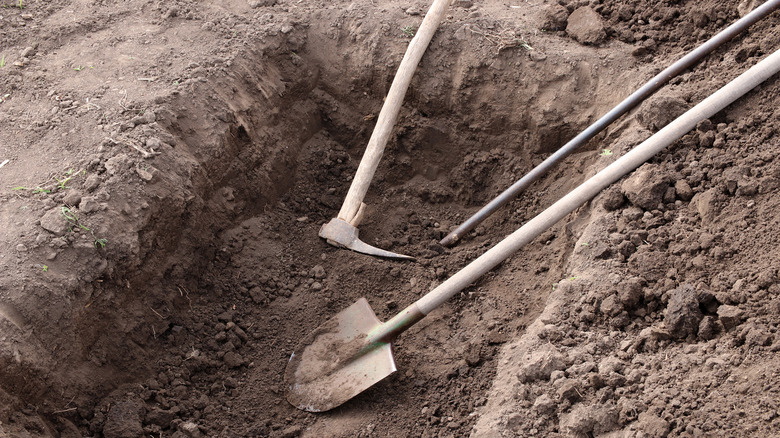The Unsolved Mystery Of LA's Elysian Park Treasure
Let's be honest: if folks in LA talk about lost gold, they're probably doing a reading from a knock-off "National Treasure" script or something. Or maybe they're talking about the legend of an old, funny, short indie film that passed from hand to hand on DVD in the '90s but was never digitized and is gone forever. But if they're talking about actual, physical buried treasure, they might just be referring to the legend of buried gold under the hills and grass of Elysian Park near Dodger's Stadium north of Chinatown.
Los Angeles might not be your first go-to location when thinking of likely buried treasure spots. After all, the city is a massive, multiborough sprawl of concrete blocks, endlessly clogged roadways, and a population of nearly 4 million people. Remember, though, that a scant 170 years ago in 1850 Los Angeles was a dusty wasteland with a population of about 1,600. And if folks are going to be doing any shoving of chests of gold into dirt to hide them from prowling hands, it would have been back then.
Lucky for us, we can see a reenactment of that precise scenario on a show from the '90s that did get digitized: "Unsolved Mysteries." And bonus: you get to hear host Robert Stack's awesome voice as he narrates the proceedings. Since then sites like Mysterious Writings and Travel Trivia have followed up on the tale, a tale that perfectly illustrates the never-ending human desire to uncover buried treasure.
Stashed away during the Mexican-American War
The tale of Elysian Park's treasure starts half a country away in a state that remains standout to this day: Texas. Back in 1836 Texas declared itself independent from Mexico and became a sovereign nation — the Republic of Texas — with its own constitution modeled after the U.S. Constitution. Settlers from the U.S. had flooded into the sparsely populated Texan desert in the years leading up to independence, and more or less took over the region from its Spanish-speaking inhabitants. And in a textbook case of "turnabout is fair play," even though the U.S. officially recognized Texan independence in 1837, the U.S. went and annexed the nascent nation a scant eight years later in 1845, per the U.S. State Department.
Gobbling up Texas was just the next step in President James Polk's territorial agenda. It set the stage for the Mexican-American war, which broke out the next year in 1846 when Mexican troops apparently opened fire on U.S. troops in Texas, as PBS overviews. Polk had the excuse he needed, and by 1848 two years later the Mexican-American war was over. Per the Treaty of Guadalupe Hidalgo, the U.S. consumed a massive swath of Mexican territory that took its westward expansion all the way to the Pacific Ocean. The deal included parts of Wyoming, Colorado, New Mexico, and the modern states of Arizona, Nevada, Utah, and yes, California. And mere days before the treaty was signed, per History, folks struck Californian gold.
Evidence of lost treasure
The Californian Gold Rush started in 1848, the same year that Mexico ceded the entire, modern U.S. southwest to their rather brute, imperialist neighbor. But if the story of Elysian Park's treasure is to be believed, Mexicans living in the region knew of its cache of gold long before Americans got there.
As the tale goes — and as "Unsolved Mysteries" described and reenacted in a 1994 episode — "well-to-do Angelenos" caught wind of U.S. troops closing in on the area in 1846 at the onset of the Mexican-American war. "According to stories handed down over the years," inhabitants took different strategies for escaping the American onslaught. Some supposedly dug escape tunnels, while others buried family fortunes that were, assumedly, too heavy to tote around. And yes, this means straight-up, stereotypical wooden chests of gold bullion, jewels, etc., worth millions of dollars.
It's a pretty generic story, but maybe that's why it's endured — that and its utter lack of specificity. "Treasure Expert" Roy Flush, as his title on "Unsolved Mysteries" calls him, helped popularize the tale, and is also mentioned on sites like Travel Trivia. When speaking of the rationale behind Angelenos burying their possessions to protect them in a time of war, Flush says, "This was the best thing they could do to protect their valuables at the time. And it was a customary way because there were no banks. If you wanted to protect something, bury it, hide it."
The hunt continues
In the present day, folks jogging through Elysian Park won't see hillsides of treasure hunters plunging shovels into the dirt. That's good, because "it is illegal to dig in any park area with any tool" in California, as Metal Detecting Hobby Talk cites. That being said, "sifting through the top few inches of sand or fir bark in play areas is acceptable so long as they [treasure hunters] do not use any tools or inconvenience playground users." Metal detectors are okay, but digging tools are not.
This is exactly why treasure hunter Robert Flush on "Unsolved Mysteries" carried a metal detector into Elysian Park to poke around a bit. He found some unusual indentations on one rock, and what looked like the initials "OC" on another. Flush also found an honest-to-goodness hole in the dirt that went down 30 feet. At the bottom were a couple of old flashlight batteries and some frayed rope, leading him to conclude that the treasure of Elysian Park did indeed exist and was already discovered and extracted.
The hunt, however, goes on. As recently as 2019, folks on the forum Treasure Net brought up Elysian Park, complete with a map and old newspaper clipping. This isn't the only spot where hopefuls might find buried treasure in Los Angeles, either. In 1995 the Los Angeles Times listed five other locations (via Newspapers.com), such as Monterey Park and Camp 19. And so the legend of lost Californian gold lives on.



